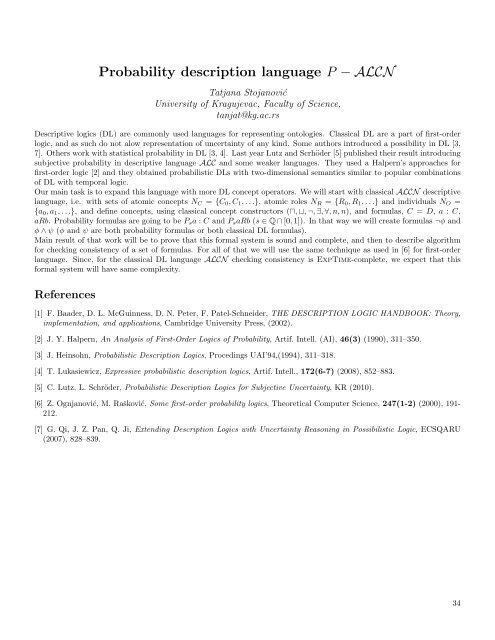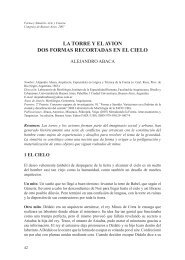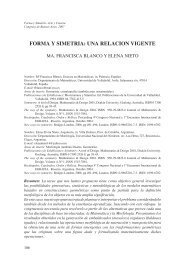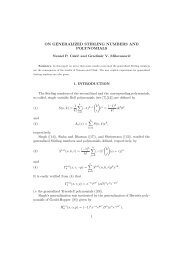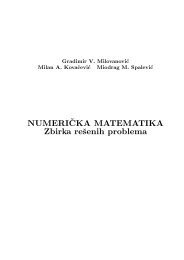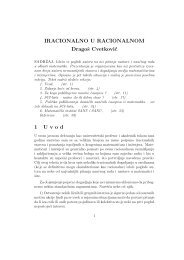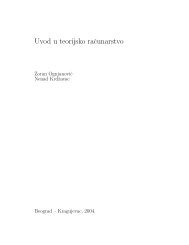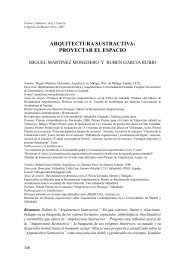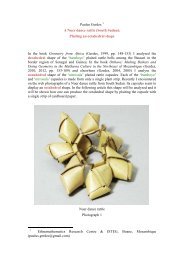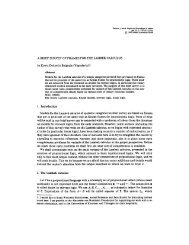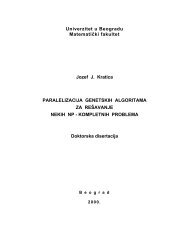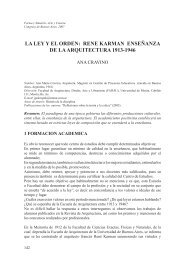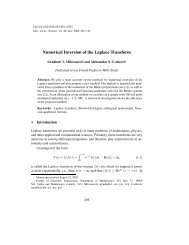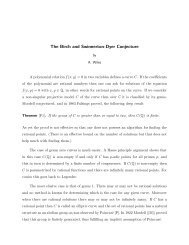Knjiga apstrakata - Mathematical Institute of the Serbian Academy of ...
Knjiga apstrakata - Mathematical Institute of the Serbian Academy of ...
Knjiga apstrakata - Mathematical Institute of the Serbian Academy of ...
You also want an ePaper? Increase the reach of your titles
YUMPU automatically turns print PDFs into web optimized ePapers that Google loves.
Probability description language P − ALCNTatjana StojanovićUniversity <strong>of</strong> Kragujevac, Faculty <strong>of</strong> Science,tanjat@kg.ac.rsDescriptive logics (DL) are commonly used languages for representing ontologies. Classical DL are a part <strong>of</strong> first-orderlogic, and as such do not alow representation <strong>of</strong> uncertainty <strong>of</strong> any kind. Some authors introduced a possibility in DL [3,7]. O<strong>the</strong>rs work with statistical probability in DL [3, 4]. Last year Lutz and Scrhöder [5] published <strong>the</strong>ir result introducingsubjective probability in descriptive language ALC and some weaker languages. They used a Halpern’s approaches forfirst-order logic [2] and <strong>the</strong>y obtained probabilistic DLs with two-dimensional semantics similar to popular combinations<strong>of</strong> DL with temporal logic.Our main task is to expand this language with more DL concept operators. We will start with classical ALCN descriptivelanguage, i.e. with sets <strong>of</strong> atomic concepts N C = {C 0 , C 1 , . . .}, atomic roles N R = {R 0 , R 1 , . . .} and individuals N O ={a 0 , a 1 , . . .}, and define concepts, using classical concept constructors (⊓, ⊔, ¬, ∃, ∀, n, n), and formulas, C = D, a : C,aRb. Probability formulas are going to be P s a : C and P s aRb (s ∈ Q ∩ [0, 1]). In that way we will create formulas ¬φ andφ ∧ ψ (φ and ψ are both probability formulas or both classical DL formulas).Main result <strong>of</strong> that work will be to prove that this formal system is sound and complete, and <strong>the</strong>n to describe algorithmfor checking consistency <strong>of</strong> a set <strong>of</strong> formulas. For all <strong>of</strong> that we will use <strong>the</strong> same technique as used in [6] for first-orderlanguage. Since, for <strong>the</strong> classical DL language ALCN checking consistency is ExpTime-complete, we expect that thisformal system will have same complexity.References[1] F. Baader, D. L. McGuinness, D. N. Peter, F. Patel-Schneider, THE DESCRIPTION LOGIC HANDBOOK: Theory,implementation, and applications, Cambridge University Press, (2002).[2] J. Y. Halpern, An Analysis <strong>of</strong> First-Order Logics <strong>of</strong> Probability, Artif. Intell. (AI), 46(3) (1990), 311–350.[3] J. Heinsohn, Probabilistic Description Logics, Procedings UAI’94,(1994), 311–318.[4] T. Lukasiewicz, Expressive probabilistic description logics, Artif. Intell., 172(6-7) (2008), 852–883.[5] C. Lutz, L. Schröder, Probabilistic Description Logics for Subjective Uncertainty, KR (2010).[6] Z. Ognjanović, M. Rašković, Some first-order probability logics, Theoretical Computer Science, 247(1-2) (2000), 191-212.[7] G. Qi, J. Z. Pan, Q. Ji, Extending Description Logics with Uncertainty Reasoning in Possibilistic Logic, ECSQARU(2007), 828–839.34


